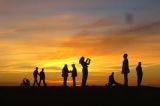- Forum
- General Discussion | Introductions | Off Topic Forum
- Photography General Discussion
- Night photography and aperture setting - conflicting info?
Night photography and aperture setting - conflicting info?
-
 Topic Author
Topic Author
- Wi1tt13
- New Kid On The Block
-
- Canon EOS t2i
- Followers: 8
- Posts: 35
-
Points:
0
Post #193365
So question is, do I set it to the smallest f stop (ie. 2.8, 1.8, etc) or the largest (ie. 18, 22, etc)?
I also assume I would only use the upper and/or lower ends of f stops - why/when would I use the f stops in between (5.6,11, 15, etc)
-

- Martini
- New Kid On The Block
-
- Nikon D700
- Followers: 10
- Posts: 43
-
Points:
0
-

- Martini
- New Kid On The Block
-
- Nikon D700
- Followers: 10
- Posts: 43
-
Points:
0
Post #193372
Britt340 wrote: Look at a depth of field table. Factor in your camera to subject distance and focal length.
Plus the focal length of your lens is a factor too.
Using a 12 mm lens, on a crop sensor camera, at f/2.8, with a focal point 200 feet from the camera, the near limit of the DOF is 8.42 feet in front of the camera, and the far limit is at infinity. Online Depth of Field Calculator
For comparison, if you are using a 18-55 mm kit lens at 18 mm, and wide open at f/3.5, with that same 200 foot focal point distance the near limit of the DOF is then 14.6 feet in front of the camera, and the far limit is still at infinity.
-
 Topic Author
Topic Author
- Wi1tt13
- New Kid On The Block
-
- Canon EOS t2i
- Followers: 8
- Posts: 35
-
Points:
0
Post #193376
Britt340 wrote: Look at a depth of field table. Factor in your camera to subject distance and focal length.
thanks for the tip, but unfortunately I'm not very good at guesstimating the distances of building/landscapes - which is why i just play is safe and set to f22 and focus on infinity. Hopefully over time I can better hone this skill and determine my distances better.
-
 Topic Author
Topic Author
- Wi1tt13
- New Kid On The Block
-
- Canon EOS t2i
- Followers: 8
- Posts: 35
-
Points:
0
Post #193377
Martini wrote:
Britt340 wrote: Look at a depth of field table. Factor in your camera to subject distance and focal length.
Plus the focal length of your lens is a factor too.
Using a 12 mm lens, on a crop sensor camera, at f/2.8, with a focal point 200 feet from the camera, the near limit of the DOF is 8.42 feet in front of the camera, and the far limit is at infinity. Online Depth of Field Calculator
For comparison, if you are using a 18-55 mm kit lens at 18 mm, and wide open at f/3.5, with that same 200 foot focal point distance the near limit of the DOF is then 14.6 feet in front of the camera, and the far limit is still at infinity.
Thanks for the DOF calculator. Too bad I can't use this out in the field when I am shooting.
-

- Henry Peach
- Apprentice
-
- I currently use a 5DII or Sony Nex-3 most of the time.
- Followers: 50
- Posts: 2925
-
Points:
16
Post #193379
Besides aperture DOF is effected by focal length and focusing distance. You can have shallow DOF with f/22 and deep DOF with f/2.8.
-

- Henry Peach
- Apprentice
-
- I currently use a 5DII or Sony Nex-3 most of the time.
- Followers: 50
- Posts: 2925
-
Points:
16
Post #193382
Wi1tt13 wrote: Thanks for the DOF calculator. Too bad I can't use this out in the field when I am shooting.
There are apps for phones. Also this DIY paper model lightingmods.blogspot.com/2008/05/diy-de...ield-calculator.html
I've used the online calculators to make some notes on common settings I would use.
Digital DOF scales as a feature for our cameras is long over due.
-
 Topic Author
Topic Author
- Wi1tt13
- New Kid On The Block
-
- Canon EOS t2i
- Followers: 8
- Posts: 35
-
Points:
0
Post #193384
Henry Peach wrote: Is the subject in the tutorial the sky or mostly far from the camera? Even f/1 can be focused to include infinity within the DOF. Depending on the gear "infinity" can be pretty close for some cameras. For instance using 18mm @ f/2.8 on an APS-C format DSLR the hyperfocal distance is less than 20', and with focus set there DOF extends from 10' to infinity. That would be fine for a lot of landscape photography. If the goal is to get as much stars in the sky that look sharp (rather than star trails) they would want to use a fast shutter speed.
Besides aperture DOF is effected by focal length and focusing distance. You can have shallow DOF with f/22 and deep DOF with f/2.8.
The subject in one of the tutorials was the sky, but I'm not trying to shoot the sky for night photography. I am more trying to shoot buildings or anything that is lite up at night (of course sky is included, but not the subject.
-
 Topic Author
Topic Author
- Wi1tt13
- New Kid On The Block
-
- Canon EOS t2i
- Followers: 8
- Posts: 35
-
Points:
0
Post #193386
Henry Peach wrote:
Wi1tt13 wrote: Thanks for the DOF calculator. Too bad I can't use this out in the field when I am shooting.
There are apps for phones. Also this DIY paper model lightingmods.blogspot.com/2008/05/diy-de...ield-calculator.html
I've used the online calculators to make some notes on common settings I would use.
Digital DOF scales as a feature for our cameras is long over due.
Wow, thank you. I didn't think about searching for an app.
-

- Henry Peach
- Apprentice
-
- I currently use a 5DII or Sony Nex-3 most of the time.
- Followers: 50
- Posts: 2925
-
Points:
16
Post #193390
Wi1tt13 wrote: The subject in one of the tutorials was the sky, but I'm not trying to shoot the sky for night photography. I am more trying to shoot buildings or anything that is lite up at night (of course sky is included, but not the subject.
If you are shooting large things (buildings, bridges...), and including most of the thing in the composition, whatever focal length lens you choose, the field of view is going to force you to be far enough away that large apertures will give you plenty of DOF.
Reasons to keep the exposure short as possible would be to take less time, conserve power, keep the sensor from heating up (noise), and to freeze movement. With film there is also the issue of reciprocity failure. If you don't have any of those concerns, or have reasons to want a long shutter speed then go for it.
-

- effron
- Newbie
- Followers: 1623
-
Points:
129640
-

- KCook
- Photo Elder
-
- Canon EOS 50D and Olympus E-P5
- Followers: 1325
- Posts: 5410
-
Points:
32913
Post #193439
Wi1tt13 wrote:
Britt340 wrote: Look at a depth of field table. Factor in your camera to subject distance and focal length.
thanks for the tip, but unfortunately I'm not very good at guesstimating the distances of building/landscapes - which is why i just play is safe and set to f22 and focus on infinity. Hopefully over time I can better hone this skill and determine my distances better.
BTW, f/3.5 is commonly called the "bigger" aperture, not f/22. As the actual iris opening is physically larger at f/3.5. Our happy f/-stop scale is a ratio that stands this on its head.
My main interest is landscape, and I rarely shoot smaller than f/14. Very small apertures like f/22 typically soften the image slightly. When I do use f/22 it's usually for close subjects, not landscapes.
Kelly Cook
Post #193517
For situations with lower light you'd need more light coming into the camera, so you need to have the lens more open or use a higher ISO or a slower shutter speed to get enough light (although with too slow a shutter speed you'd be more likely to get blur from shutter movement).
If you're getting conflicting info. maybe look at the source of information; anybody can do a blog/website and there's a lot of info. online that isn't necessarily accurate. You might try photography organizations, or photography magazines for articles and links to reliable resources.
Sharon
- Forum
- General Discussion | Introductions | Off Topic Forum
- Photography General Discussion
- Night photography and aperture setting - conflicting info?
Latest Reviews
The Olympus Pen E-P7 is an affordable micro four thirds mirrorless camera with 4K video capabilities, a 20.3MP sensor, and 121 focus points, making it a solid entry-level camera for beginners.
The Panasonic G9 II is a 25.2-megapixel micro four thirds camera with numerous features that make it punch out of its weight class, like 779 AF points, 5.8K video, and weather sealing.
The Fujifilm XT5 is a 40MP mirrorless camera capable of 6.2K video at 30p. With those specs, it’s an ideal choice for photographers needing a camera to pull double duty for imaging and video.
The Canon EOS R100 is an entry-level mirrorless camera introduced in 2023. But just because it’s an entry-level camera doesn’t mean it’s a bare-bones camera. Find out why in this review!
Forum Top Posters
-
1Scotty 9 posts
-
2Roman Omell 4 posts
-
3Razky 4 posts
-
4Pat White 3 posts
-
5CharleyL 3 posts
-
6ShutterPal 3 posts
-
7Ruby Grace 3 posts
-
8Roger Lang 3 posts
-
9Nefarious 3 posts
-
10Jim Photo 3 posts
Latest Articles
Upgrade your kit in 2024 with the best intermediate camera on the market! The question is, what camera fits the bill? We’ve got three top options for you to choose from in this buyer’s guide.
The best photography jobs right now are a mix of tried-and-true gigs like wedding photography and new jobs highlighting AI’s capabilities, travel, and videography.
The Olympus Pen E-P7 is an affordable micro four thirds mirrorless camera with 4K video capabilities, a 20.3MP sensor, and 121 focus points, making it a solid entry-level camera for beginners.
Starting a photography business is one thing; sustaining your business over a long period of time is another. Use the tips in this professional photography guide to build something with longevity!
The Panasonic G9 II is a 25.2-megapixel micro four thirds camera with numerous features that make it punch out of its weight class, like 779 AF points, 5.8K video, and weather sealing.
Cinematic photography is an interesting genre that combines photographic and videographic skills along with effective storytelling techniques. The result? Highly impactful images!
Newborn photography requires skill, the right gear, and a lot of patience. This beginner’s guide discusses critical topics that will help you be more prepared for before, during, and after the shoot.
To fill the frame means to expand the footprint of the subject in your shot. Get in close, zoom in, crop the image, or use other techniques to bring the subject to the forefront.
















